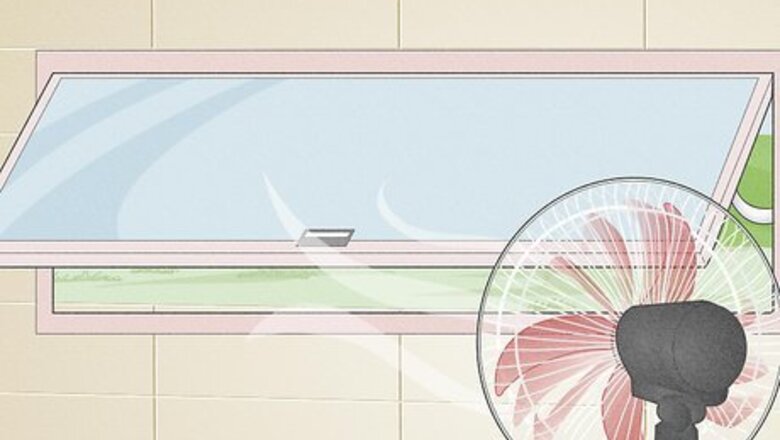
views
X
Trustworthy Source
Centers for Disease Control and Prevention
Main public health institute for the US, run by the Dept. of Health and Human Services
Go to source
If you’re ready to get rid of nasty, moldy caulk for good, read on!
- Scrub the caulk with bleach diluted in water to kill and remove mold.
- Alternatively, spray the mold with white distilled vinegar and let it sit for 1 hour.
- Ammonia, baking soda, and hydrogen peroxide are also great options for cleaning moldy caulk.
Using Bleach
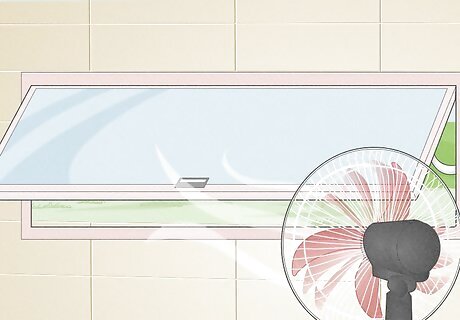
Ventilate the bathroom and put on a respirator mask and gloves. Chlorinated bleach creates harsh fumes when you use it, so open the bathroom door, any windows, and turn on the exhaust fan if you have one. Then, protect yourself by putting on a respirator mask and a pair of gloves.
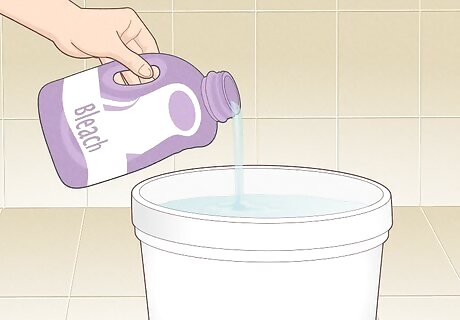
Mix 1 cup (240 mL) of bleach with 1 gal (3.8 L) of water. Move outside or into a well-ventilated room, like your kitchen, and open the doors or windows. Then, measure 1 cup (240 ml) of chlorinated bleach and pour it into 1 gallon (3.8 L) of water.
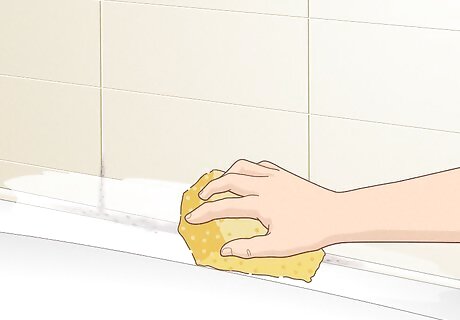
Soak a sponge in the bleach solution and scrub the mold if it’s light. If you’re only dealing with a minor case of moldy caulk, simply grab a fresh scrubbing sponge. Soak it in your solution and squeeze out the excess. Then, use it to scrub the caulk and remove the mold. Black mold looks gross, but it’s not any more dangerous than other molds. Sneezing and coughing are the most common symptoms of exposure to black mold, though people who are allergic to mold might develop an allergic reaction.
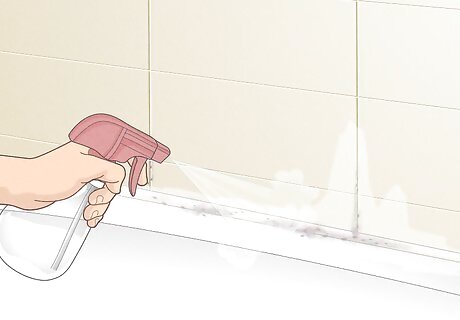
Spray moderately moldy caulk, let it sit for 5-10 minutes, and then scrub. If a sponge doesn’t remove the mold by itself, fill a spray bottle with your bleach solution. Then, spray the moldy caulk. Give the bleach 5 to 10 minutes to soak in, then scrub the caulk with your sponge.
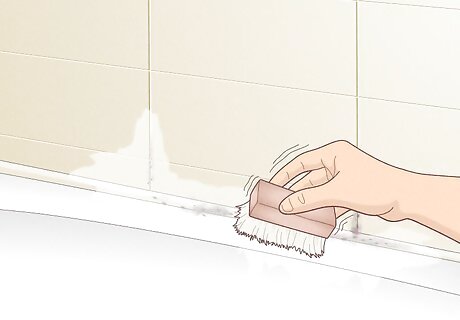
Apply the bleach spray again and scrub it with a cleaning brush. If a sponge still isn’t removing the mold, spray the caulk again. Just let the bleach spray soak into the caulk for 5 to 10 minutes. Then, scrub the caulk with a soft-bristled brush or toothbrush.
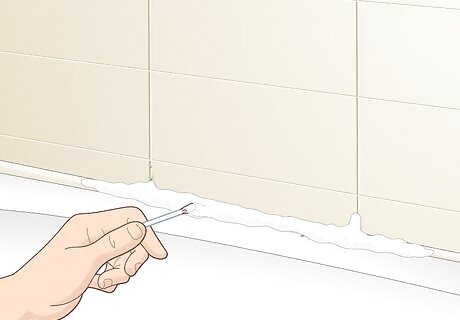
Soak the caulk with cotton balls overnight to kill deep-rooted mold. If spraying the caulk doesn’t seem to penetrate the mold, soak cotton balls or toilet paper in the bleach solution. Then, place the cotton balls along the caulk line wherever the mold is growing. Leave them on the caulk for several hours or overnight so the bleach has plenty of time to seep into it. In the morning, wipe the caulk down with a damp cloth or sponge.
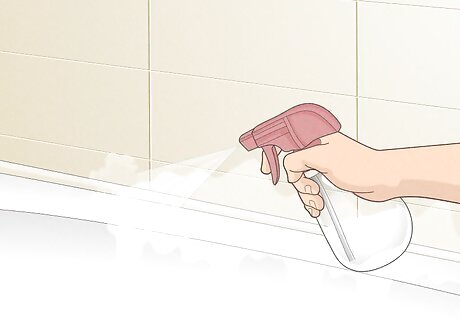
Spray the caulk again to prevent mold from coming back. Give the caulk in your tub or shower one last spray of the bleach solution. Instead of wiping it up, let it stay in place. Leaving the bleach on the caulk helps stop new mold from growing. EXPERT TIP Ashley Matuska Ashley Matuska Professional Cleaner Ashley Matuska is a Professional Cleaner at the Founder and Owner of Dashing Maids in Denver, Colorado. Ashley has over seven years of experience in the cleaning industry. She and her team specialize in offering sustainable deep cleaning and maintenance cleaning services. Ashley Matuska Ashley Matuska Professional Cleaner Clean your shower regularly and dry it after each use to prevent mold from growing. Ashley Matuska of Dashing Maids says: "Bleach is excellent for killing mold, and it can often turn faded and discolored grout back to its original color. In the future, though, the best thing you can do is to be diligent about cleaning on a regular basis. If the mold is growing in the shower area, dry the walls and the door of your shower every time you use it, because mold can build up very quickly."
Using Ammonia
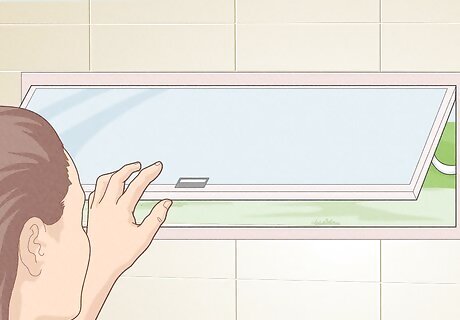
Ventilate the bathroom. Ammonia can have harmful effects when you inhale it, so improve the air circulation in your bathroom as much as possible. Open any windows, prop open the door, switch on the exhaust fan, and even set up a standing fan to get the air moving. Warning: ammonia and bleach create toxic fumes when they are mixed. If you’ve already sprayed the caulk with bleach, do not follow it up with ammonia.
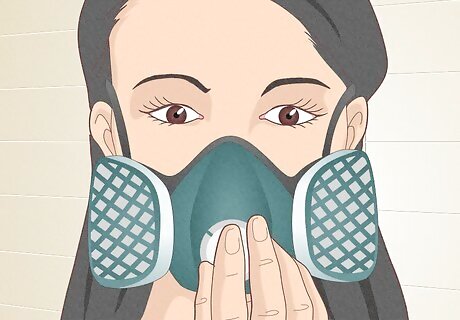
Put on a respirator mask, gloves, and goggles. To add an extra layer of protection, filter out the ammonia fumes with a respirator. Just choose an activated charcoal cartridge respirator that’s designed for ammonia use and seal it snugly to your face. Then, put on a pair of gloves and goggles to protect your hands and eyes from the ammonia, too.
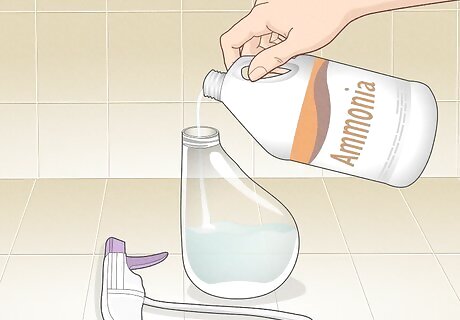
Mix equal parts ammonia and water in a well-ventilated area. Move outside or into a room in your home that gets good airflow, like your kitchen. Then, mix together equal parts of ammonia and water directly into a spray bottle. Or, combine them in a bowl and then pour the solution into a spray bottle with a funnel.
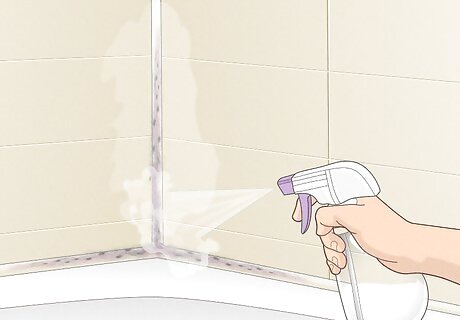
Spray the caulk, wait 5-10 minutes, then scrub it with a brush. Evenly coat the moldy caulk with the ammonia solution. Let it sit for 5 to 10 minutes to give it time to work its magic and kill the mold. Then, scrub the solution into the caulk with a soft-bristled brush like a toothbrush or a scrubbing sponge. Wipe the caulk down with a damp cloth or sponge to remove all traces of the ammonia solution when you’re finished.
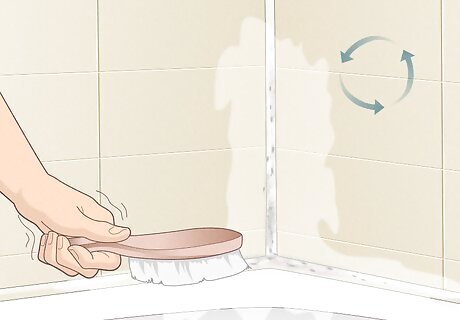
Apply the ammonia again if the caulk is still moldy. Ammonia is an effective mold killer, but it sometimes takes extra effort for it to remove mold on porous surfaces like caulk. Simply spray the caulk again if your first application of the ammonia solution didn’t kill or remove all the mold. If you still see mold, move on to one of the non-toxic cleaning options in the steps below.
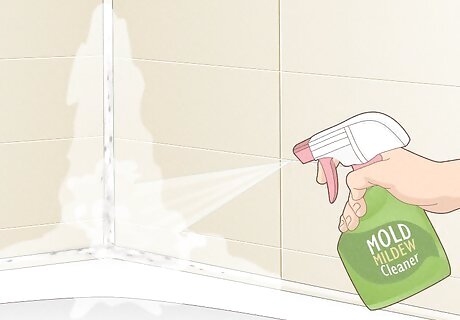
Use another cleaner if the mold returns. While ammonia typically removes the mold on the surface of the caulk, the mold might be embedded deep within the caulk. If the mold reappears soon after you clean it, use one of the other solutions below to remove it.
Using Non-Toxic Mold Killers
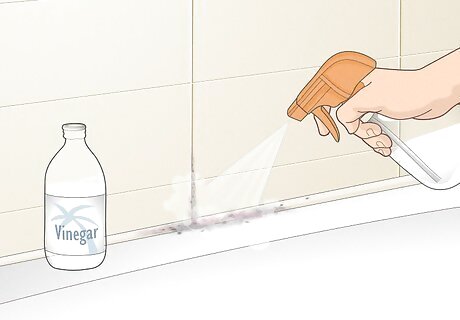
Soak the caulk in white distilled vinegar for 1 hour. Simply fill a spray bottle with vinegar. Spray it onto the moldy caulk and let it soak in for 1 hour. Then, wipe the mold away from the caulk with a damp sponge or cloth and rinse the area with water. White vinegar also helps prevent mold. After you take a shower or bath, spray the caulk and the surrounding area with vinegar. Vinegar can soften and pull up silicone caulk, so don’t leave it on for much longer than 1 hour. Then, scrub the caulk very gently to prevent any damage.
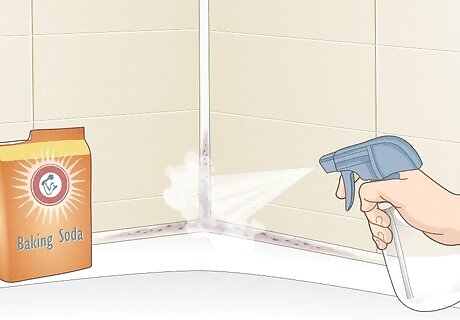
Mix baking soda with water and spray it on the caulk. Pour 1 tablespoon (17 g) of baking soda and 2 cups (473 ml) of water into a spray bottle. Shake up the bottle to mix the ingredients. Then, spray the mold on the caulk and scrub it clean with a sponge or soft brush. Simply rinse the caulk with water and spray it with the solution again to stop the mold from growing back. Or, mix 1 part baking soda with 1 part water to create a paste. Spread the paste onto the caulk and let it sit for 30 minutes, or until it dries out. Then, scrub the baking soda with a sponge or brush.
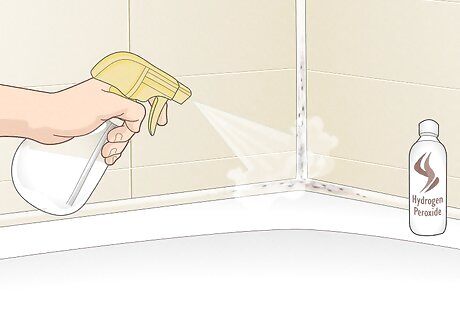
Spray and scrub the caulk with 3% hydrogen peroxide. Fill a spray bottle with 3% hydrogen peroxide and spray the moldy caulk until it’s thoroughly soaked. Then, let the cleaner soak into the caulk for about 10 minutes. Scrub the caulk with a sponge or a soft-bristled brush to lift and remove the mold. Just wipe the caulk down with a damp cloth or sponge when you’re finished scrubbing.
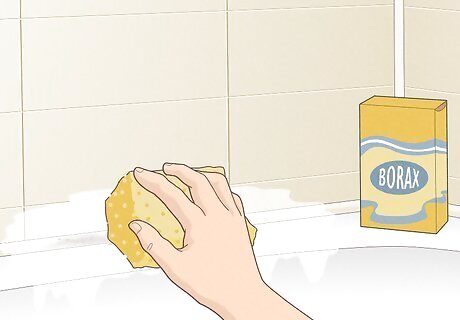
Clean moldy caulk with a borax and water solution. Add 1 cup (204 g) of borax to 1 gallon (3.8 L) of water in a bowl or container. Then, soak a scrubbing sponge in the solution and rub it into the mold on the caulk. Or, fill a spray bottle with the borax solution. Spray the caulk, scrub the borax in with a brush, and then wipe it clean with a damp cloth.
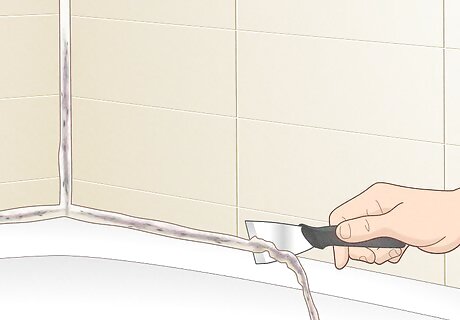
Remove the old caulk if the mold won’t budge. Sometimes mold grows behind the caulk or is too ingrained inside it for regular cleaning solutions to remove it. To take out your old caulk, slice the edges with a utility knife or razor. Then, push the edge of a putty knife between the caulk and the shower or tub wall to gently pry it off. Spray and scrub the area with 1 cup (240 mL) of bleach mixed in 1 gallon (3.8 L) of water. Then, dry the shower or tub before you recaulk it. If the caulk is too hard to pry up at first, heat it with a heat gun or hair dryer to soften it. Or, spray it with a caulk remover.
Preventing Mold
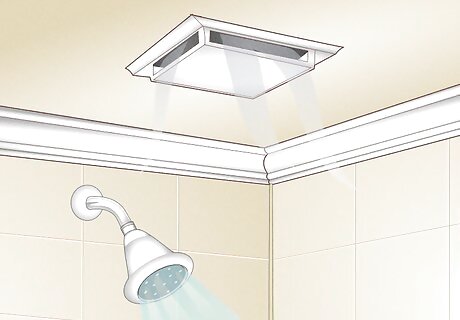
Turn on your bathroom’s exhaust fan when you take a shower. Mold thrives in hot, humid environments, so improve your bathroom’s ventilation and airflow as much as you can. If you have an exhaust fan, turn it on when you start showering and keep it on for at least 30 minutes after you’re done. If you don’t have an exhaust fan, put a dehumidifier in your bathroom to absorb moisture, or a standing fan to circulate more air. If you have a shower with a glass door or walls, use a squeegee to remove excess water each time you bathe. Dry any areas in your bathroom where mold tends to develop to prevent future growth.
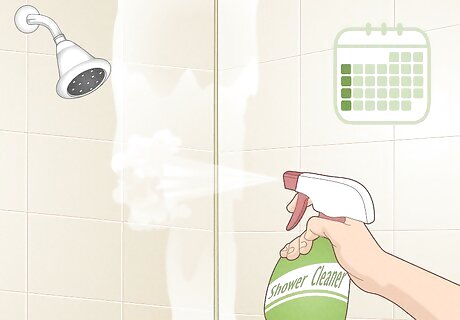
Clean your shower or bathtub weekly and give it a deep clean monthly. To keep your shower in pristine, mold-free condition, wipe it down once a week with a commercial shower cleaner or your own mix of 1 part white vinegar and 1 part water. Then, give it a deep cleaning once a month, spending extra time scrubbing the caulk, grout lines, and shower head. If you have a glass shower, wipe the glass walls with a glass cleaner.
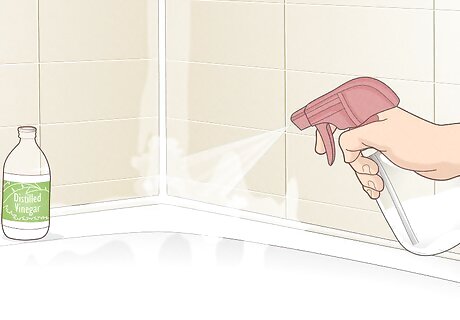
Spray caulk with vinegar or a commercial mold killer after each shower. Keep mold at bay in between your weekly cleaning, too. When you get out of the shower, mist the caulk with white vinegar or a shower spray that fights mold. This helps create a harsh environment where not even the toughest mold can grow.
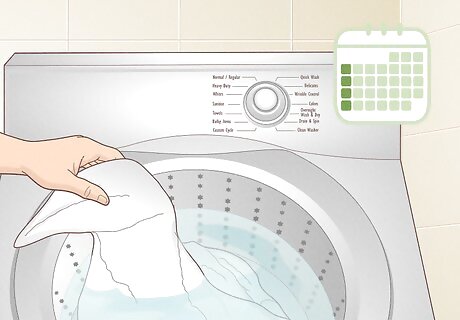
Wash your towels and bath mats weekly. Your bath towels and rugs absorb a lot of water, which can keep your bathroom moist and prone to mold if they’re not washed and dried often. So, just make it a habit to throw them in your washing machine about once a week. If you have a fabric shower curtain, wash it about once a month.















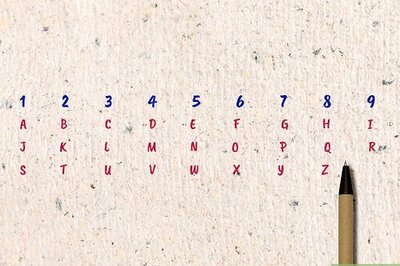




Comments
0 comment